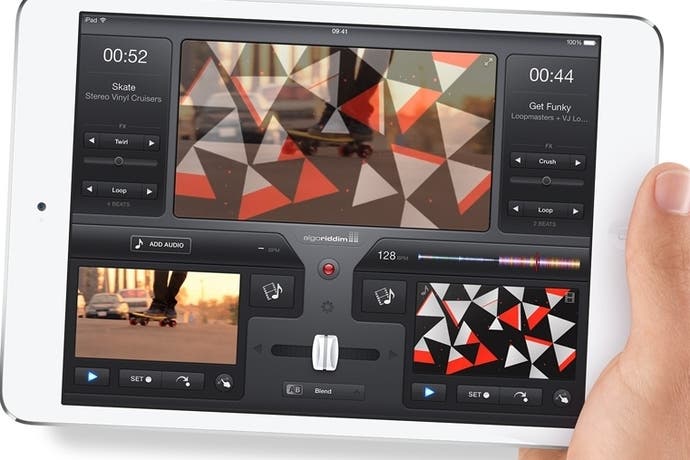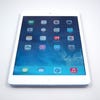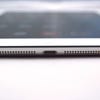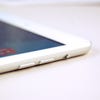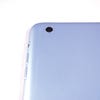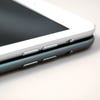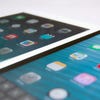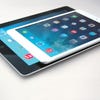Retina iPad mini review
Lighter than Air.
It was - and in many ways, still is - a genius product. Last year's iPad mini slotted in beautifully between the iPhone and its 9.7-inch tablet sibling, with Apple effectively downscaling its wildly successful A5-powered iPad 2 into an ultra-small, exceptionally thin tablet. The mini didn't have anything like the raw power of its contemporary sibling - the fourth-generation iPad - but at the time it didn't really need it. Form factor is everything in the mini's case, and the sheer feel and complete portability of the product made it our default choice for tablet tasks in an office where we also had equal access to both of last year's devices. The only disappointment was a lacklustre screen - something that has been resolved for this second-generation model. However, in the case of the new iPad mini with Retina display, the screen is just the beginning of the story.
First impressions aren't exactly overwhelming if you're familiar with the existing mini. To all intents and purposes, the second-generation product is identical to the first - the form factor is a very close match to last year's, the only differences amounting to a piffling 0.3mm of added thickness along with a 23g increase to the weight (don't worry - your existing Apple Smart Cover will work, but be careful with third-party aftermarket alternatives).
As you'd expect from an Apple product, build quality and materials are exceptional. This isn't a cheap product - it's actually £50 more expensive than last year's offering, which is still on sale - but you pay for what you get and the quality of the device is generally excellent, with just one caveat specific to our unit we'll go into a little later. While the slight increase in weight might come across as a bit of a disappointment on paper in an era where we demand our electronics to get smaller and lighter as a matter of course, it's a trade we're more than willing to make bearing in mind what you get in return.
Powering up the new mini reveals an impressive IPS display that - in resolution terms at least - is a complete match for the 9.7-inch iPad Air, with the full 2048x1536 of real estate on offer. The difference is pixel density: the Air lands at 264 pixels per inch, while the Retina mini hands in an impressive 326ppi. However, while the raw numbers are a match, there is the sense that the smaller iPad isn't getting quite the same quality from its display. Side by side, the iPad Air still has a certain vibrancy in the image that sets it apart from both the iPad 4 and this second-gen mini. Also, our store-bought mini also had a slight magenta tinge at the top of the screen, only noticeable when viewing pure whites, but enough to make us want a replacement. When Apple sets the bar so high on its products - and charges a premium for the privilege - we do expect everything to be perfect.
Last year's mini was a well-balanced product. The A5 processor had more than enough CPU and GPU power to hand in a quality experience on the 1024x768 screen - indeed, while it handed in an improved browsing and multitasking experience, the iPad 4's A6X chip had some issues keeping up with it in some 3D-intensive games since it simply did not have enough horsepower to drive four times the pixel count. Titles like Infinity Blade 2 even ran at sub-native resolutions to compensate. With the mini now running at pixel parity, Apple has made a remarkable decision - it has unified both of the new iPads and the iPhone 5S on its new 64-bit A7 architecture.
There are implications here. The processor runs at a lower clock speed on the phone platform, but the advantages of running an 1136x640 display up against a 2048x1536 screen are obvious - more GPU resource per pixel, meaning generally higher frame-rates on demanding 3D games. On paper at least, the mini operates as a halfway house between the 5S and the iPad Air - it reports the same 100MHz CPU deficit as the smartphone, but manages to hand in overall performance only a hair's breadth away from the Air - presumably owing to the larger chassis allowing for more thermal headroom. However, in terms of GPU performance at least - there's nothing to separate the two new iPads. Running challenging games like Infinity Blade 3, Real Racing 3, Asphalt 8, Deus Ex: The Fall and XCOM: Enemy Unknown produces absolutely no perceivable difference between the two tablets that we could pick up upon.
The conclusion here is that despite the large difference in form factor - and by extension, thermal dissipation characteristics - plus a wide gulf in battery capacity (23.8WHr vs. 32.4WHr), both the Retina iPad mini and the larger iPad Air essentially offer like-for-like performance. What is more remarkable still is that battery life in most tasks (browsing, media playback, for example) remains pretty much identical - though by our reckoning you lose around 30-40 minutes if you dedicate the entire charge to 3D gaming.
"Last year the choice between the two iPad offerings was power vs. portability. This year's mini represents two years' worth of performance upgrades, bringing the smaller device closer into line with the iPad Air."
The near-parity in overall battery life illustrates a couple of hardware aspects rather nicely. Firstly, the combination of a 28nm process for the A7 plus its power-saving features results in a continuation of the iPad's reputation as a device that lasts - on average - for around 10 hours per charge, regardless of which iPad you buy. That's really impressive bearing in mind we're looking at technology that doubles the performance of the iPad 4's A6X, which required a mammoth 42.5WHr battery. Secondly, in comparing the mini to the Air, it also reveals just how much juice that larger, higher-quality screen requires.
The only other nips and tucks you're likely to notice come from the stereo speakers. Understandably, they don't have quite the same presence as the iPad Air and they share one of the few annoyances of the larger tablet - during gameplay it's all too easy to cover up the speakers when the device is held on its side. Also, as per the Air, any sense of a stereophonic effect is lost in this configuration as both speakers point in the same direction.
In terms of onboard cameras, this new edition of the iPad mini appears to offer the exact same equipment as its larger brother, with a five-megapixel rear snapper and front-facing 720p camera for Skype and FaceTime functionality. Quality here isn't that bad at all, and the form factor of the mini makes the device a far better bet for photography than the iPad Air, and in this sense it is a bit of a shame that the dual-LED flash from the iPhone 5S isn't incorporated. Overall though, the camera side of things is competent - but not exceptional.
"While the Cyclone CPU cores are downclocked compared to the iPad Air, the GPU seems to be untouched, resulting in a smaller iPad with only the tiniest of performance cutbacks compared to its larger sibling."
| Retina iPad mini | iPad Air | iPad 4 | iPad Mini | Nexus 7 | Nexus 10 | |
|---|---|---|---|---|---|---|
| Geekbench 3 (single/multi-core) | 1380/2516 | 1482/2698 | 785/1428 | 268/501 | 583/1838 | 862/1528 |
| Sunspider 0.9.1 (Java) | 411.8ms | 405.2ms | 840.8ms | 1606.5ms | 736.6ms | 873.3ms |
| Kraken 1.1 (Java) | 6000.3ms | 5613.1ms | 16699.9ms | 36261.4ms | 10513.8ms | 7930.5ms |
| GFX Bench 2.7 T-Rex HD (offscreen) | 25fps | 25fps | 16fps | 3fps | 15fps | 12fps |
| GFX Bench 2.7 Egypt HD (offscreen) | 63fps | 63fps | 50fps | 15fps | 39fps | 39fps |
| 3DMark Ice Storm Unlimited | 14089 | 14842 | 10814 | 2680 | 11489 | 8790 |
iPad mini with Retina display - the Digital Foundry verdict
Let's get the bad news out of the way first. While this is a smaller, more affordable iPad, it's certainly not cheap, weighing in at $399/£320 for the cheapest 16GB offering. Similar to the contrast between last year's model and its corresponding Nexus 7 equivalent, there's still a yawning chasm in terms of cost between the entry-level iOS and Android tablets. Apple has continued to pursue a premium quality approach to its products and despite the price hike over last year's mini, the chances are that it's still going to be a runaway success.
And that's going to be down to the good news. The new iPad mini is a feature-complete miniaturisation of the iPad Air - a product that even our Android specialist, Damien McFerran, rated as the best tablet experience he'd ever had. There's no compromise to resolution and no impact to performance in any area, be it browsing or gaming, and even the battery life remains extremely impressive, with the only noticeable hit coming from extended 3D gameplay. What made the original mini such a hit remains virtually unchanged: the form factor is beautiful - extremely portable, but with a screen large enough for a highly satisfactory browsing experience.
So the question is, if you're looking for a tablet, which one to buy? In terms of price vs. performance, it's really difficult to recommend anything other than the Nexus 7. It lacks the premium finish of the iOS equivalent and over time we've come to accept that the 4:3 screen Apple opts for tends to suit browsing better, but as an all-in-one device packing plenty of power it's difficult to beat. However, if you're set on an iOS device, the choice between the new Retina-equipped mini and the iPad Air isn't easy at all - despite their many similarities, each has its strengths and weaknesses.
Last year's mini was a revelation. It made the iPad 4 look and feel like a hulking, cumbersome throwback - and despite the gulf in silicon specs, the mini still managed to hand in decent enough performance. As a tablet to stow in a travel bag, or just to play around with in the living room, the more powerful fourth-gen 9.7-incher was soon left by the wayside in favour of the smaller device. This time around, Apple has closed the gap by addressing deficiencies at both ends: the smaller model is now as powerful as its larger sibling, while the new iPad Air may be larger, but crucially it still passes the one-handed usage test.
Assuming the base-model £90 cost differential isn't an issue, to our minds the choice of which iPad to buy comes down to what you want to get out of it. While the divide in portability has been reduced, the mini remains the iOS device of choice for tablet activity inside and outside the home - easier to handle, easier to carry about with you. However, the changes Apple has made to the 9.7-inch model are considerable - it no longer feels like a dead weight in your hands and it's a joy to use. The screen, meanwhile, is palpably superior to the mini's (not just in terms of size) and this in turn makes it a more versatile machine - it provides a better media experience, both in terms of screen-size and audio. On top of that, it's also the form factor of choice as a productivity device. Apple's decision to make its Office, photo and media apps available for free signals a move to transition the perception of the iPad from a consumption-only device into something more flexible - a tablet that aims to put the final nails in the coffin of the entry-level laptop market.
